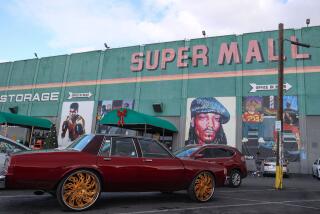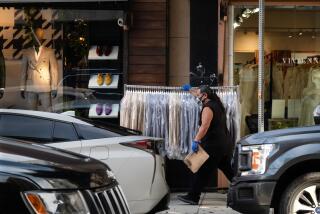Tug of War : Consumers love the lower prices, but O.C. designers hate it when their merchandise shows up at swap meets or discount warehouses without their consent.
- Share via
Mention the word “diverters” to Mossimo Giannulli, and the Irvine-based fashion designer grows noticeably agitated.
After calling them a few choice names, he calms down just a little:
“They’re people who see an opportunity when a label’s hot to make extra dough,” he says. “It’s so unethical.”
His sentiments are shared by another Orange County designer, Shawn Stussy, as well as the people at Quiksilver, Vans and other manufacturers who have been stymied by diverters.
Diverters buy popular brand name goods such as Mossimo T-shirts or Vans tennis shoes from retailers and distributors and sell them to stores and discounters that aren’t authorized to carry them.
That’s how a name such as Mossimo, which is typically carried at specialty shops, can end up at a swap meet or a discount chain such as Price Club. Giannulli once discovered 1,000 of his T-shirts at Price Club selling for $5 below their regular retail price.
Although consumers benefit, the practice drives manufacturers crazy. They invest heavily in advertising and marketing to cultivate the right image for their product. If their customers see their in-season merchandise in a swap meet or other undesirable location, the goods can lose their mystique, they say.
“If (diverting) happens at all, it’s a big problem,” Giannulli says. “You work so hard to create an image. That’s all you really have.”
On three occasions Giannulli has bought back his merchandise to keep the Mossimo name out of Price Club and other discount chains. The latest incident took place six months ago, when he purchased $20,000 of Mossimo apparel from a discounter.
“If you’re in a store with less of an image than you’re trying to portray, it can hurt your image. It scares the hell out of me, because I want to be here a while,” he says.
Diverting is a headache for Stussy as well. An unauthorized surf-and-sport shop in Newport Beach not only sells Stussy designs purchased from diverters, it occasionally features Stussy in its window display.
Such tactics hurt those stores that legitimately buy and sell the Stussy line, says Shawn Stussy, president of the Irvine-based men’s clothing company.
“It might be a great store, but it could be across the street from a guy who’s been with us since the get-go,” Stussy says.
In addition, diverting can saturate the market with too much product.
“By controlling the size, you control the hipness” of your merchandise, Stussy says. “By not being in every store, you’re known as an exclusive thing.”
Vans also takes diverting seriously. The company hires detectives to hunt down diverters, polices swap meets and discount stores to see if they are carrying Vans shoes and secretly marks merchandise to find out which of its distributors is rerouting orders.
“If we sell to a distributor and his agreement is to sell Vans shoes to Mexico and we find them in Los Angeles at a swap meet, it could damage our name,” says Craig Gosselin, vice president and general counsel for Vans Inc. in Orange. “Vans has a reputation for quality that people don’t associate with heavily discounted goods. It hurts.”
There are many methods of diverting, but one of the most common occurs when a retailer has leftover stock and sells it to a diverter, who then turns around and sells the goods to an unauthorized party.
Such incidents are on the rise because the recession has left some retailers with excess merchandise they need to unload, says Frank Quinlan, a former FBI agent and attorney who handles white-collar fraud cases with Kester & Quinlan in Newport Beach.
Distributors, the go-betweens between manufacturers and retailers, get into the act by violating their agreements with manufacturers to only sell the goods in certain markets, Quinlan says.
“They might only be able to sell in Newport Beach, but if the market is slow in Newport Beach they may turn around and sell the goods in another country,” he says.
They can also sell their surplus inventory to a local discounter, who can afford to charge less than the full retail price charged by finer stores.
“Most distributors mark up the goods, and the retailer marks it up even further,” Gosselin says. “If a diverter isn’t selling it to the retailer, he is selling it to a discounter who has a low overhead and won’t need to take as high of a markup.”
Sometimes diverting takes place at the shipyards--when merchandise earmarked for one country gets rerouted to another country that has lax import and trademark laws. Distributors have been known to agree to sell goods to a South American country, then turn around and sell their orders to France or another country where they can bring a higher price, Quinlan says.
“A T-shirt that sells for $15 in Newport Beach might sell for $40 in France,” Quinlan says. “There’s a profit incentive to divert.”
Quiksilver, a Costa Mesa-based sportswear company, has found diverting to be a global problem. Sometimes Quiksilver goods bound for South America will be transferred to Europe, where they can fetch higher prices, says Tom Holbrook, vice president of sales for Quiksilver. Products can even find their way back into the United States.
“There’s a black market for anything that’s popular,” Holbrook says.
Stopping diverters is not easy.
In the United States there is no law that prohibits someone from selling a product purchased from someone else. To protect themselves, manufacturers draw up contracts with their distributors that specify where the goods can be sold.
“If they break the agreement, it’s a breach of contract. The manufacturer can get an injunction (to stop the distributor from selling the goods) and sue,” Quinlan says. “But it can be hard to prove damages.”
The most obvious damage is hard to calculate in dollars--the loss of esteem to the product name.
“Consider St. John Knits. If you found them at Price Club, would you find them as attractive?” Quinlan says. “You’re dealing with an ego market.”
Other damages are easier to document. For instance, if a distributor diverts 10,000 T-shirts to a swap meet and “sales at local shops go down the drain, the stores won’t order more T-shirts,” Quinlan says. “The manufacturer will suffer a loss of sales” that can be proved on paper.
Still, collecting from diverters can be difficult because they are often small, fly-by-night operators.
The best solution, Quinlan says, is to try to prevent diverting from happening in the first place.
“You should have clear agreements with your distributors and let them know you won’t tolerate it,” he says.
Manufacturers can protect themselves by dealing with reputable distributors known for honoring their agreements, Quinlan says. They can also use computers to track unusually large orders. If a local distributor buys 5,000 T-shirts, then suddenly doubles the order, that can be a sign of diverting, he says.
When diverting is discovered, often the most cost-effective way to stop it is to confront the distributor and terminate the agreement. Many manufacturers, including Giannulli, immediately cut off distributors who sell to the wrong parties. If the incident involves “a big dollar impact” on the company, then a lawsuit might be in order, Quinlan says.
“Manufacturers are not defenseless,” he says. “They have the right to protect themselves from these attacks.”






